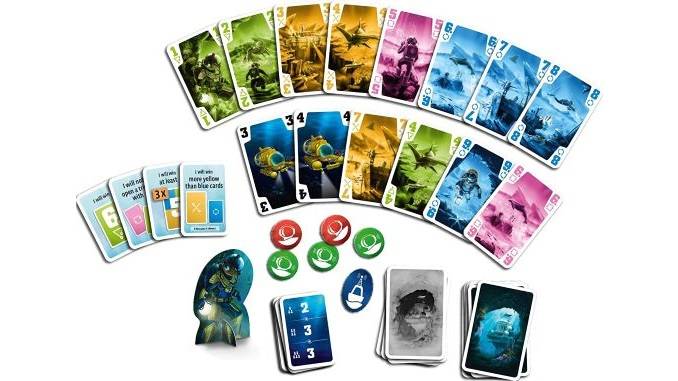The Crew Goes Underwater with Mission Deep Sea, and Improves on 2019’s Award-Winning Board Game
Games Reviews board games
The Crew: The Quest for Planet Nine was a big hit two years ago, winning the Kennerspiel des Jahres award (Experts game of the year) in 2019 for its novel take on trick-taking games: All players work together, without communicating, to achieve specific goals, like for one player to win all of the tricks, or for another player to end up with no cards of a certain color. It played out over a series of increasingly difficult challenges, with the first few more like training games, and wasn’t designed for players who want to just jump in and play a few rounds of a “normal” game.
The sequel game, The Crew: Mission Deep Sea, offers just modest changes to the original, but those modest changes produce a game that’s easier to play without its convoluted story, and the challenges involved this time around are both more interesting and more fun. It’s still the same game at heart, with mechanics that should be familiar to anyone who’s played bridge or hearts or any of the hundreds of other trick-taking games out there (I suggest Fox in the Forest if you’re looking for a simple two-player example), but I found this much easier to enjoy than the original.
The Crew: The Quest for Deep Space Nine—sorry, I can’t help it, I have been calling it that by mistake for months—has a deck of 40 cards, nine cards in each of four colors, numbered 1 through 9, plus four submarine cards numbered 1 through 4 that serve as trumps. You must follow suit if possible, and the high card in the lead card’s suit wins the trick unless someone else plays a submarine card to trump it.

The catch is that you’re all playing together, and at the start of each round, you draw one or more Task cards that tell you specific objectives for that round. The players draft those Task cards, usually one per player, and must achieve whatever goal is on that card. That might be simple, like winning the first trick (or the first two tricks), or winning a single trick with only even-numbered cards, or winning the pink 5 and the yellow 6. Many are more difficult, such as winning all cards of a specific color, or winning a fixed number of tricks that you predict before you start to play but don’t reveal to other players. You win the round, collectively, if all players complete their tasks successfully (and you don’t have to finish once that occurs). You lose if any player fails to complete a task. For most rounds, you’ll just draw task cards until their total difficulty rating (shown on the back of the cards) meets or exceeds the difficulty rating shown in the Log book for that challenge.
The catch is that you can’t communicate with other players—you can’t say what’s in your hand or what someone else should play or even if you just want to win that trick. You have one option for communicating: You may take one card from your hand, lay it on the table, and place a token on it that indicates if it is your high card of that color, your low card of that color, or your only card of that color. It’s still considered to be a card in your hand and you may play it at any time. Any other sort of communication is forbidden.
The Log book outlines specific challenges that you could complete, with increasing levels of difficulty by having you draw more tasks or adding other, extraneous restrictions on game play. The story is … not good, to put it kindly. It is as pasted-on as themes get, and there is absolutely no need to read it to play and enjoy the game. (I would argue you’re better off not reading it, because it just isn’t very well-written, and came off as very silly.) The beauty of this game versus the original is that it’s easier to craft your own challenges using the difficulty rating system, rather than just relying on the Log book to tell you how to play. I can see the appeal of playing this game or the original all the way through its 50-mission sequence, but around here, we don’t play any single game that often, and I prefer a game I can drop into at any time. This involves less commitment than a legacy game, but the campaign doesn’t add to the game play for me. If you liked the original, you’ll like The Crew: Mission Deep Sea at least as much, and I think it’s a shade better because it’s easier to start.
Keith Law is the author of The Inside Game and Smart Baseball and a senior baseball writer for The Athletic. You can find his personal blog the dish, covering games, literature, and more, at meadowparty.com/blog.